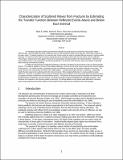| dc.contributor.author | Willis, Mark E. | |
| dc.contributor.author | Burns, Daniel R. | |
| dc.contributor.author | Rao, Rama V. N. | |
| dc.contributor.author | Minsley, Burke J. | |
| dc.contributor.other | Massachusetts Institute of Technology. Earth Resources Laboratory | en_US |
| dc.date.accessioned | 2011-12-21T23:22:57Z | |
| dc.date.available | 2011-12-21T23:22:57Z | |
| dc.date.issued | 2003 | |
| dc.identifier.uri | http://hdl.handle.net/1721.1/67868 | |
| dc.description.abstract | It is important to be able to detect and characterize naturally occurring fractures in reservoirs using surface seismic
reflection data. 3D finite difference elastic modeling is used to create simulated surface seismic data over a three layer model and a
five layer model. The elastic properties in the reservoir layer of each model are varied to simulate different amounts of vertical parallel
fracturing. The presence of the fractures induces ringing wave trains primarily at times later than the bottom reservoir reflection.
These ringy or scattered wave trains appear coherent on the seismograms recorded parallel to the fracture direction. While there are
many scattered events on the seismograms recorded perpendicular to the direction of the fractures, these events appear to generally
stack out during conventional processing.
A method of characterizing and detecting scattering in intervals is developed by deconvolution to give an interval transfer
function. The method is simple for the case of two isolated reflections, one from the top of the reservoir and the other from the bottom
of the reservoir. The transfer function is computed using the top reflection as the input and the bottom reflection as the output. The
transfer function then characterizes the effect of the scattering layer. A simple pulse shape indicates no scattering. A long ringy
transfer function captures the scattering within the reservoir interval. When analyzing field data, it is rarely possible to isolate
reflections. Therefore, an adaptation of the method is developed using autocorrelations of the wave trains above (as input) and below
(as output) the interval of interest for the deconvolution process. The presence of fractures should be detectable from observed ringy
transfer functions computed for each time interval. The fracture direction should be identifiable from azimuthal variations – there
should be more ringiness in the direction parallel to fracturing. The method applied to ocean bottom cable field data at 4 locations
show strong temporal and azimuthal variations of the transfer function which may be correlated to the known geology. | en_US |
| dc.description.sponsorship | Massachusetts Institute of Technology. Earth Resources Laboratory | en_US |
| dc.description.sponsorship | United States. Dept. of Energy (Grant DE-FC26-02NT15346) | en_US |
| dc.description.sponsorship | Eni S.p.A. (Firm) | en_US |
| dc.publisher | Massachusetts Institute of Technology. Earth Resources Laboratory | en_US |
| dc.relation.ispartofseries | Earth Resources Laboratory Industry Consortia Annual Report;2003-08 | |
| dc.title | Characterization of Scattered Waves from Fractures by Estimating the Transfer Function Between Reflected Events Above and Below Each Interval | en_US |
| dc.type | Technical Report | en_US |
| dc.contributor.mitauthor | Willis, Mark E. | |
| dc.contributor.mitauthor | Burns, Daniel R. | |
| dc.contributor.mitauthor | Rao, Rama V. N. | |
| dc.contributor.mitauthor | Minsley, Burke J. | |
| dspace.orderedauthors | Willis, Mark E.; Burns, Daniel R.; Rao, Rama V. N.; Minsley, Burke J. | en_US |
